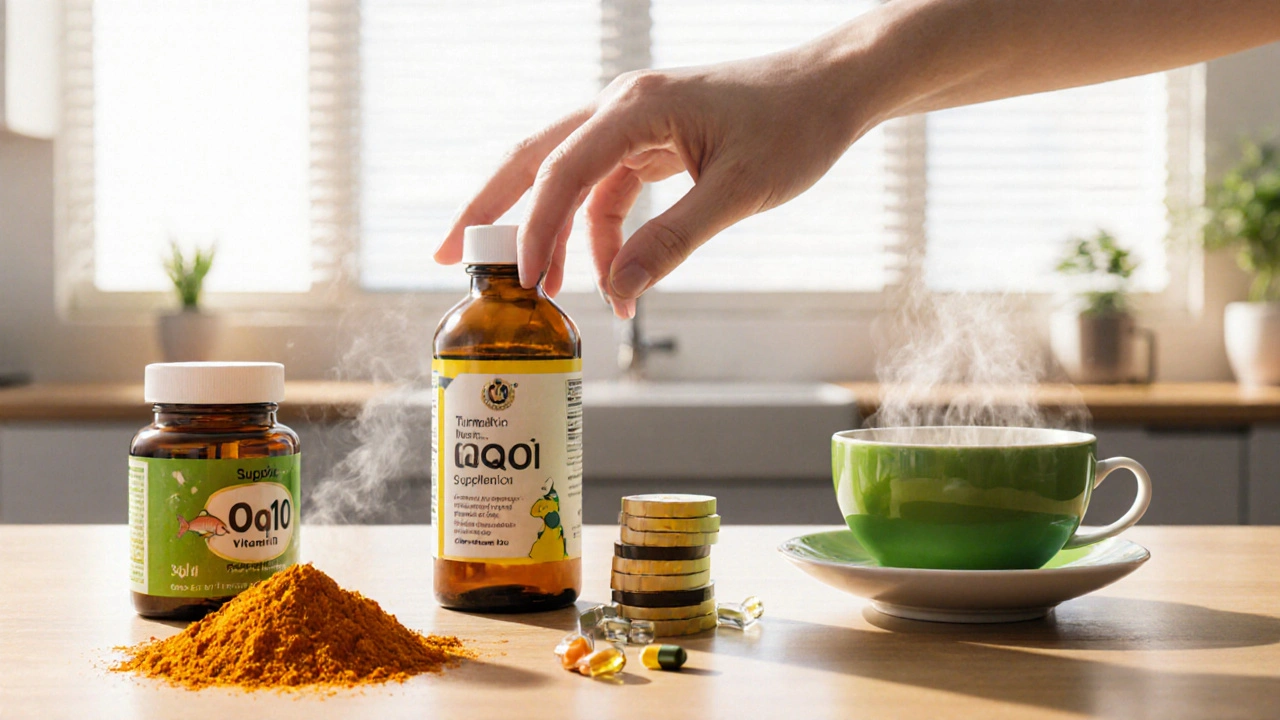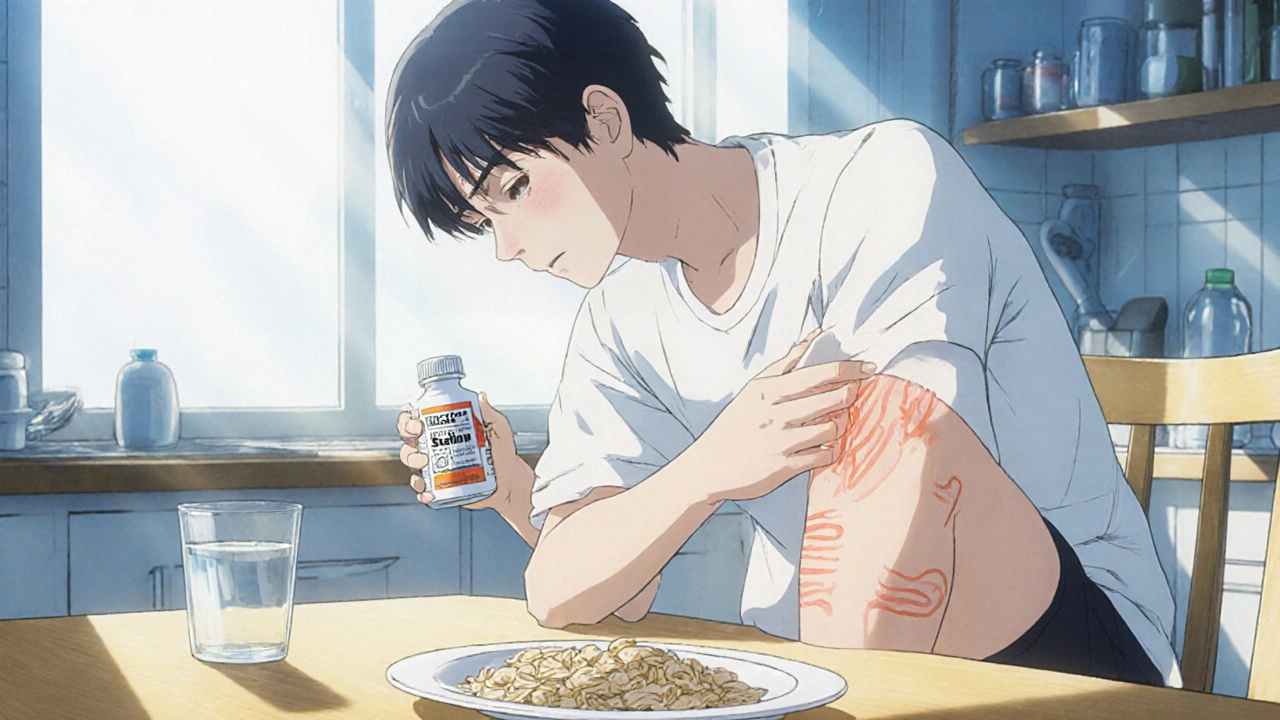If you’ve been prescribed rosuvastatin to lower cholesterol, you’ve probably heard about possible side effects like muscle aches, digestive upset, or liver‑related concerns. While doctors can adjust the dose or switch drugs, many people look for everyday strategies that don’t involve another prescription. Below is a step‑by‑step guide that blends science‑backed natural remedies with practical lifestyle tweaks, so you can keep your heart health on track without the extra discomfort.
Understanding Rosuvastatin and Its Common Side Effects
Rosuvastatin is a high‑potency statin medication used to reduce LDL‑C (bad cholesterol) and raise HDL‑C (good cholesterol) levels, thereby lowering cardiovascular risk. Like other statins, rosuvastatin works by inhibiting the HMG‑CoA reductase enzyme in the liver, cutting the body’s internal cholesterol production. Most patients tolerate it well, but the most reported issues include:
- Muscle pain or weakness (myalgia)
- Joint discomfort
- Digestive symptoms such as nausea or constipation
- Elevated liver enzymes
- Rarely, memory fog or sleep disturbances
These side effects stem from the same biochemical pathway that lowers cholesterol, often depleting nutrients your muscles and liver rely on. That’s why supplementing or adjusting your diet can make a noticeable difference.
Why Natural Remedies Can Help
Statins lower the levels of co‑enzyme Q10 (CoQ10) in the body-a molecule vital for muscle energy production. Reduced CoQ10 can translate into the dreaded muscle aches many patients feel. Additionally, statins can slightly raise blood levels of certain inflammatory markers, which fuels discomfort. By introducing antioxidants, anti‑inflammatory foods, and targeted nutrients, you can counteract these biochemical side effects without compromising rosuvastatin’s cholesterol‑lowering power.
Top Natural Strategies
Below are the most effective natural approaches, each backed by clinical or observational data. Choose the ones that fit your lifestyle, and talk to your prescriber before stacking multiple supplements.
1. Boost Coenzyme Q10
Coenzyme Q10 is a fat‑soluble antioxidant that helps generate cellular energy, especially in muscle tissue. A daily dose of 100-200 mg has been shown to reduce statin‑related myalgia in several randomized trials. Look for the ubiquinol form, which is more readily absorbed.
2. Omega‑3 Fatty Acids
Omega-3 fatty acids are polyunsaturated fats mainly found in fish oil that possess anti‑inflammatory properties. Consuming 1-2 grams of EPA/DHA daily can ease joint pain and improve lipid profiles, making them a double‑win for rosuvastatin users.
3. Dietary Fiber
Dietary fiber is the indigestible part of plant foods that helps regulate gut motility and lower cholesterol. Aim for 25-30 g per day from sources like oats, beans, and fruits. Soluble fiber (β‑glucan) directly interferes with cholesterol absorption, letting you possibly stay on a lower rosuvastatin dose.
4. Vitamin D
Vitamin D is a fat‑soluble hormone that supports bone health and modulates immune function. Low vitamin D levels are linked to increased muscle pain in statin users. A daily supplement of 1,000-2,000 IU can raise serum levels and may reduce myalgia.
5. Turmeric (Curcumin)
Turmeric is a spice containing curcumin, a potent anti‑inflammatory compound. Taking 500 mg of standardized curcumin twice daily can dampen inflammatory pathways that contribute to joint discomfort.
6. Green Tea Catechins
Green tea catechins are polyphenols that offer antioxidant and lipid‑lowering effects. Drinking 2-3 cups of brewed green tea or supplementing with 300 mg EGCG daily can support liver health and improve overall antioxidant capacity.
7. Grapefruit (Use with Caution)
Grapefruit juice can increase rosuvastatin blood levels, potentially heightening side effects. If you enjoy it, limit intake to a small glass (≈100 ml) once a week, and always discuss with your doctor.

Lifestyle Tweaks That Complement Natural Remedies
- Stay Hydrated: Adequate water helps kidneys flush out metabolites and reduces muscle cramping.
- Regular Light Exercise: Walking or gentle cycling improves circulation, which can alleviate statin‑related stiffness.
- Consistent Sleep Schedule: Quality sleep supports muscle repair and reduces perceived pain.
- Stress Management: Meditation, deep breathing, or yoga can lower cortisol, an indirect trigger for inflammation.
When to Talk to Your Doctor
Natural approaches are safe for most, but certain flags mean it’s time to seek medical advice:
- Persistent muscle pain lasting more than a week or accompanied by dark urine (possible rhabdomyolysis).
- Liver enzyme tests (ALT, AST) that double the upper‑normal limit.
- New onset memory issues or severe fatigue.
- Any allergic reaction to supplements.
If any of these occur, your physician may order blood panels, adjust the rosuvastatin dose, or switch to a different statin.

Quick Checklist for Managing Rosuvastatin Side Effects
- Start CoQ10 100 mg + 200 mg (divide dose) after meals.
- Add 1 g EPA/DHA fish oil daily.
- Consume 30 g fiber from oats, beans, and berries.
- Check vitamin D level; supplement 1,000 IU if low.
- Include 500 mg curcumin twice daily with black‑pepper extract for absorption.
- Drink 2-3 cups green tea each day.
- Limit grapefruit to ≤100 ml weekly.
- Stay hydrated (≈2 L water), walk 30 min most days, and keep a sleep log.
Comparison Table of Natural Remedies
| Remedy | Primary Benefit | Typical Dose/Frequency | Evidence Level |
|---|---|---|---|
| Coenzyme Q10 | Reduces muscle pain | 100‑200 mg daily | Strong (RCTs) |
| Omega‑3 (EPA/DHA) | Anti‑inflammatory, improves triglycerides | 1‑2 g daily | Moderate (Meta‑analyses) |
| Dietary Fiber (soluble) | Lowers LDL, improves gut health | 25‑30 g/day (oats, beans) | Strong (Epidemiology) |
| Vitamin D | Alleviates myalgia, supports bone | 1,000‑2,000 IU daily | Moderate (Observational) |
| Turmeric (curcumin) | Reduces inflammation | 500 mg twice daily | Moderate (RCTs) |
| Green Tea Catechins | Antioxidant, supports liver | 2‑3 cups tea or 300 mg EGCG | Low‑Moderate (Small trials) |
Final Thoughts
Managing rosuvastatin side effects isn’t about quitting a life‑saving drug; it’s about fine‑tuning your body’s chemistry with nutrients it might be missing. By adding a few evidence‑backed natural tools, staying active, and keeping an open line with your healthcare provider, you can keep cholesterol numbers low and quality of life high.
Can I take CoQ10 and rosuvastatin together?
Yes. CoQ10 does not interfere with rosuvastatin’s cholesterol‑lowering action and can actually reduce muscle pain. A daily 100‑200 mg dose is commonly recommended.
Is it safe to combine fish oil with rosuvastatin?
Fish oil is generally safe and may enhance lipid control. Stick to 1‑2 g of EPA/DHA per day and talk to your doctor if you’re on blood thinners.
How much fiber should I eat to help with statin side effects?
Aim for 25‑30 g of total fiber daily, with at least 5‑10 g coming from soluble sources like oats, barley, and beans.
Can vitamin D deficiency worsen statin‑related muscle pain?
Low vitamin D levels have been linked to increased myalgia in several studies. Supplementing to reach 30‑50 ng/mL serum 25(OH)D can help.
Should I avoid grapefruit completely while on rosuvastatin?
Grapefruit can boost rosuvastatin levels and increase side‑effect risk. If you love it, limit to a small glass (≈100 ml) once a week and get your doctor’s OK.

14 Comments
Ben Dover October 26 2025
While the article correctly cites the depletion of CoQ10 as a mechanistic cause of statin‑induced myalgia, it neglects to acknowledge the interindividual variability in mitochondrial resilience. A rigorous assessment of baseline plasma CoQ10 levels would allow for a more personalized supplementation strategy, rather than the blanket recommendation of 100 mg daily. Moreover, the pharmacodynamic interaction between rosuvastatin and high‑dose ubiquinol deserves a cautious titration schedule, especially in patients with renal insufficiency. The omission of potential drug‑nutrient interactions, such as with warfarin, compromises the clinical applicability of the guide. In sum, the recommendation is scientifically sound but lacks the granularity requisite for advanced therapeutic decision‑making.
Katherine Brown October 27 2025
I appreciate the comprehensive overview and the emphasis on evidence‑based dosages, which reflects a commendable commitment to patient safety. The inclusion of precise intake ranges for omega‑3 and fiber provides clear guidance for clinicians and lay readers alike. Your cautionary note regarding grapefruit interactions is particularly prudent, given the variability in cytochrome P450 metabolism. Overall, the article balances scientific rigor with practical accessibility, which is essential for informed shared decision‑making. Thank you for presenting the material with such scholarly poise.
Ben Durham October 28 2025
Great job breaking down the science into everyday actions that anyone can try. The step‑by‑step format makes it easy to pick one change at a time, starting with something simple like a glass of water. Adding CoQ10 after meals, as you suggest, aligns well with its fat‑soluble nature and improves absorption. I also like the reminder to check vitamin D levels before jumping to supplementation – that’s a responsible approach. Keep sharing these practical health tips; they really help bridge the gap between research and daily life.
Tony Stolfa October 30 2025
Honestly, most of these “natural hacks” sound like marketing fluff for the supplement industry. If you really want to avoid muscle pain, just ask your doc to lower the rosuvastatin dose – it’s not rocket science. Sure, a handful of fish oil capsules won’t hurt, but don’t expect them to magically erase side effects. The real fix is tailoring the statin to your genetics, not sprinkling turmeric on your toast. Bottom line: stay skeptical of one‑size‑fits‑all remedies.
Joy Dua October 31 2025
Statins are chemical agents that alter the body's internal equilibrium and in doing so they provoke a cascade of compensatory mechanisms. One must contemplate the dialectic between pharmaceutical intent and physiological response. The depletion of CoQ10 exemplifies a reductionist view that neglects systemic harmony. Therefore supplementing ubiquinol restores balance and mitigates the discord introduced by lipid‑lowering therapy. This perspective invites a more holistic integration of medicine and metabolism. Ultimately, the body is a symphony where each nutrient plays a vital note.
Holly Kress November 1 2025
Thank you for highlighting the importance of staying hydrated and moving regularly; those lifestyle tweaks are often overlooked. Encouraging patients to keep a simple water bottle handy can make a big difference in muscle comfort. Pairing gentle exercise with adequate rest also supports mitochondrial health, which aligns with the CoQ10 recommendations. Your checklist format is user‑friendly and promotes adherence without overwhelming the reader. It’s reassuring to see such a balanced approach that respects both pharmacology and everyday habits.
Chris L November 2 2025
I love how the guide encourages collaboration between patients and their healthcare providers when considering supplements. The suggestion to check vitamin D levels before supplementing shows respect for individualized care. Emphasizing regular light exercise, like a 30‑minute walk, adds an uplifting, achievable goal for anyone on rosuvastatin. Staying hydrated is a simple habit that can prevent many discomforts, and it’s great you reminded us of that. Together, these strategies empower us to take proactive steps toward better heart health.
Charlene Gabriel November 3 2025
It is truly heartening to see a resource that not only lists supplements but also weaves them into a narrative of holistic well‑being, acknowledging that each individual’s journey with rosuvastatin is uniquely nuanced. First, the emphasis on CoQ10 resonates deeply because the scientific literature repeatedly demonstrates its capacity to alleviate myalgia, especially when administered in the ubiquinol form, which boasts superior bioavailability compared to the oxidized counterpart. Second, the recommendation to incorporate omega‑3 fatty acids dovetails nicely with cardiovascular benefits already attributed to these polyunsaturated fats, thereby offering a dual‑action mechanism that both tempers inflammation and supports lipid profiles. Third, the dietary fiber suggestion is clever, as soluble fibers like β‑glucan not only lower LDL cholesterol through sterol binding but also foster a healthy gut microbiome, which recent studies link to reduced systemic inflammation. Fourth, the reminder to assess vitamin D status before supplementation respects the principle of evidence‑based medicine, avoiding unnecessary over‑supplementation while addressing a common deficiency that can exacerbate muscle pain. Fifth, the inclusion of turmeric curcumin, especially when paired with black pepper for enhanced absorption, provides a natural anti‑inflammatory agent that aligns with the article’s overall theme of mitigating statin‑induced discomfort. Sixth, the green tea catechins recommendation introduces a potent antioxidant that may protect hepatic function, an important consideration given the occasional rise in liver enzymes with statin therapy. Seventh, the cautious note on grapefruit juice reflects an understanding of cytochrome P450 interactions, reminding readers that even natural foods can modulate drug metabolism in unpredictable ways. Moreover, the lifestyle tweaks-adequate hydration, gentle aerobic activity, consistent sleep hygiene, and stress management-form a comprehensive lifestyle scaffold that supports overall metabolic resilience. By integrating these practical steps, patients are empowered to take ownership of their health, which can, in turn, enhance medication adherence and therapeutic outcomes. Additionally, the checklist format at the end serves as an actionable roadmap, allowing individuals to track their progress and make incremental adjustments without feeling overwhelmed. It also facilitates meaningful dialogue with clinicians, who can then tailor dosing or consider alternative statins based on the patient’s reported experiences. The article’s balanced tone-neither dismissive of concerns nor overly fearful of pharmacotherapy-creates a safe space for readers to explore adjunctive strategies. In a healthcare landscape often dominated by siloed approaches, this synthesis of pharmacologic insight, nutraceutical evidence, and lifestyle wisdom stands out as a model for patient‑centered care. Finally, the invitation to consult healthcare providers before stacking multiple supplements underscores a commitment to safety, reinforcing that natural does not automatically mean risk‑free. Altogether, this guide exemplifies how thoughtful, evidence‑backed recommendations can transform the patient experience from one of passive acceptance to proactive partnership.
Leah Ackerson November 4 2025
The journey of managing medication side effects is akin to navigating a labyrinth of biochemical signals 🔄, where each supplement acts as a potential torchlight 🕯️. While CoQ10 shines brightly for muscle health, we must remember that over‑reliance can mask deeper metabolic imbalances 🧩. Balance, therefore, is the philosopher’s stone that turns the lead of discomfort into the gold of well‑being ✨. 🌱
Gary Campbell November 6 2025
Some readers overlook the fact that the supplement industry is heavily funded by shadowy interests that stand to profit from chronic medication use. The push for fish oil and turmeric often comes with subtle marketing embedded in seemingly neutral research. It is no coincidence that the same labs producing these studies also receive grants from pharmaceutical lobbyists. Consequently, the “natural” label can be a smokescreen, diverting attention from the need for deeper investigation into statin alternatives. Maintaining a critical eye is essential when evaluating such recommendations.
renee granados November 7 2025
Stop mixing supplements without a doctor’s order.
Stephen Lenzovich November 8 2025
From an American perspective, we should prioritize proven, FDA‑approved therapies over untested “herbal” remedies that often lack rigorous oversight. While CoQ10 has some data, it pales in comparison to the extensive clinical trials that underpin rosuvastatin’s efficacy. Embracing a balanced approach that respects regulatory standards preserves both public health and national scientific credibility. Moreover, indiscriminate use of supplements can strain healthcare resources and distract from core preventive measures. Let us champion evidence‑based medicine while remaining vigilant against unfounded hype.
abidemi adekitan November 9 2025
Your guide paints a vivid mosaic of options, each color representing a different pathway to comfort and heart health. The suggestion to sip green tea feels like adding a brushstroke of antioxidants to the canvas of daily routine. Incorporating fiber is like laying a sturdy foundation upon which cholesterol can be gently lowered. I also love the idea of pairing curcumin with black pepper – it’s a culinary hack that boosts absorption while delighting the palate. Keep sharing such rich, inclusive advice; it empowers the community to craft their own masterpiece of wellness.
Barbara Ventura November 10 2025
Wow, this article really covers a lot, from CoQ10 to grapefruit, and even includes practical tips like staying hydrated, which is absolutely essential, especially when you’re on medication, and the suggestion to walk regularly is something we can all fit into our busy lives, plus the emphasis on checking vitamin D levels, which many people overlook, really shows a thoughtful approach, and the checklist at the end makes it easy to track progress, so kudos to the author for such a comprehensive, user‑friendly guide.